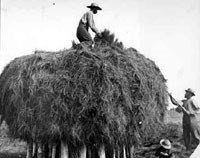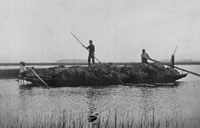
In later centuries, hay may have been grown on the many islands on which farming and husbandry took place (see below) in order to support the livestock being raised on those islands. An exception was Spectacle, where in 1742 the hay raised on the island was taken to South Boston (Sweetser 1988 [1888]:176). More common were islands where the hay grown was used on that island itself. This was certainly the case on Thompson, where the Farm School raised hay to feed its cows and horses, cutting over 100 tons in one year in the early 20th century (Stanley 1966:58). Hay was grown in the late 19th century on the Brewer estate at Worlds End (Walker and Walker 1984:45). Hay was also raised on Grape after it was acquired c.1892 by owners of a polo ground in Hingham who used the island to grow hay for and graze their polo ponies (Arato et al. 2000: Grape). 
In contrast to the Boston Harbor Islands, where haying was done by private individuals or in connection with the institutions or estates on the islands, haying on the islands in Maine was a commercial activity. Hay grew naturally on the outer islands whose acid soils-the result of seabird nesting-precluded the growth of forests. From pre-Revolutionary times onward hay was harvested on Metinic and the Green Islands for sale in Boston, for example (McLane and McLane 1997:14). Prepared by Nancy S. Seaholes, 2009 |
Last updated: February 26, 2015
